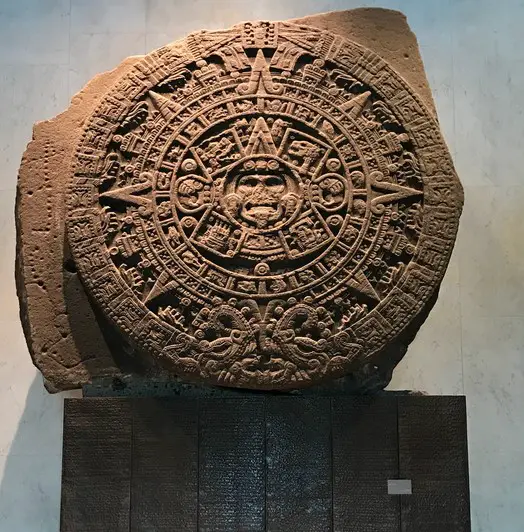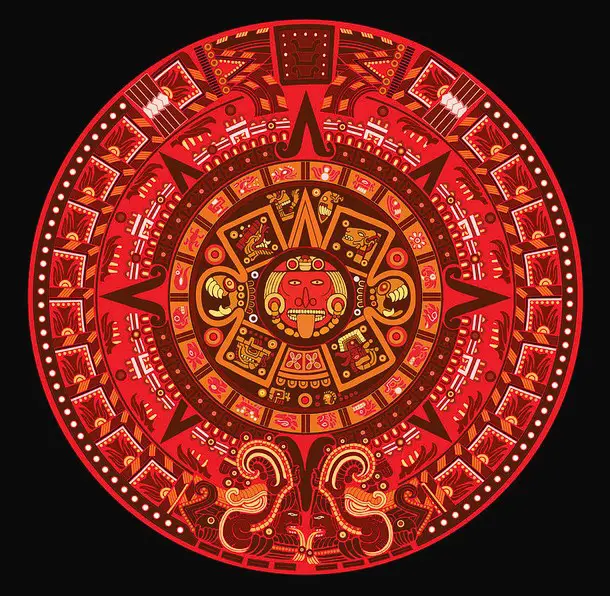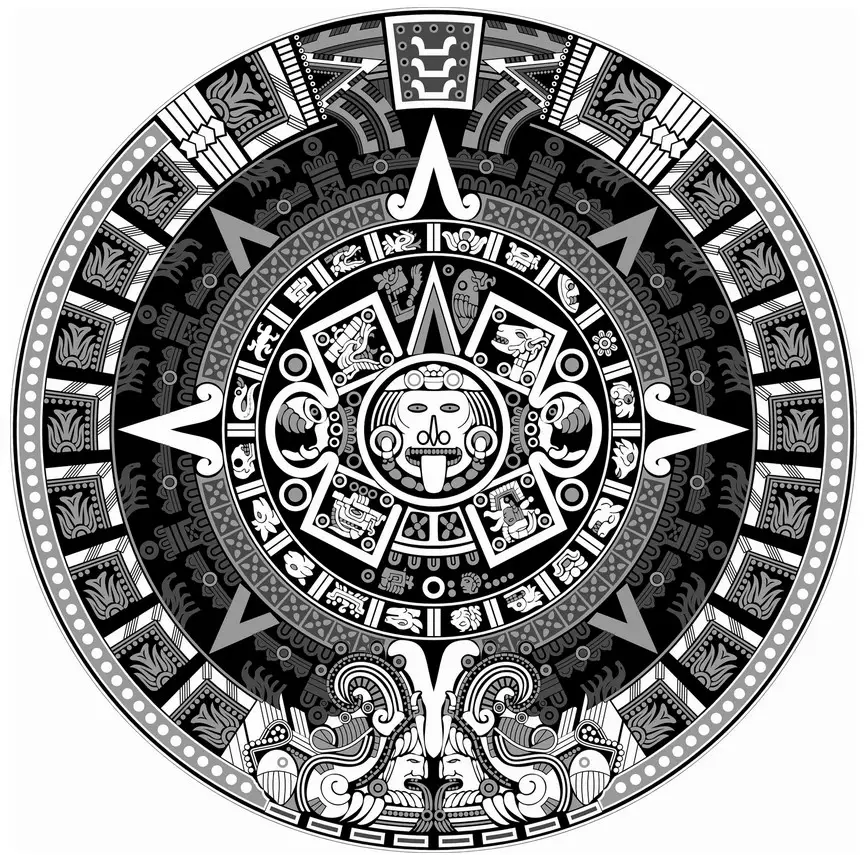Podcast: Play in new window | Download
Subscribe: Apple Podcasts | RSS
 The date was December 17, 1790. José Damián Ortiz de Castro was called over to a trench being dug as part of the renovations to Mexico City’s Plaza Principal now known as the Zócalo. Viceroy Juan Vicente de Güemes had charged Ortiz with overseeing one of the largest revitalization efforts in colonial Mexico City. The viceroy ordered to be built a series of drains, sewers and sidewalks and other improvements to modernize the aging capital of New Spain, which at that point had been occupied by the Spanish for 270 years. Ortiz, a seasoned architect from Puebla, had distinguished himself as the designer of the towers of Mexico City’s Metropolitan Cathedral and he was also the architect who created the Casa de Moneda or the Mexican Mint. On that chilly day in December, Ortiz was amazed at what the workers in the Plaza Principal had uncovered. Before him lay a gigantic carved stone, measuring some twelve feet across. Workers brushed away the dirt and some recognized the face on the stone staring back at them. It was Tonatiuh, the ancient Aztec god of the sun. It took much time and effort to unearth the basalt monolith which was over three feet thick and weighed over 54,000 pounds. From an upstairs window at the viceregal palace, the viceroy himself watched with curiosity as the workers struggled with their ropes and pulleys to get the stone out of the ground. In the meantime, the king’s representative in Mexico City called on the expertise of a man named Antonio de León y Gama, one of the realm’s prime intellectuals known for his deep understanding of astronomy and mathematics as well as his knowledge of pre-Hispanic cultures and civilizations. When Antonio de León y Gama saw the gigantic Aztec artifact, he assumed it was a calendar and hence the stone got its name, “The Aztec Calendar Stone.” Although there are some calendrical references on the carving, it is not an actual Aztec calendar, and is more accurately described as “The Aztec Sun Stone.”
The date was December 17, 1790. José Damián Ortiz de Castro was called over to a trench being dug as part of the renovations to Mexico City’s Plaza Principal now known as the Zócalo. Viceroy Juan Vicente de Güemes had charged Ortiz with overseeing one of the largest revitalization efforts in colonial Mexico City. The viceroy ordered to be built a series of drains, sewers and sidewalks and other improvements to modernize the aging capital of New Spain, which at that point had been occupied by the Spanish for 270 years. Ortiz, a seasoned architect from Puebla, had distinguished himself as the designer of the towers of Mexico City’s Metropolitan Cathedral and he was also the architect who created the Casa de Moneda or the Mexican Mint. On that chilly day in December, Ortiz was amazed at what the workers in the Plaza Principal had uncovered. Before him lay a gigantic carved stone, measuring some twelve feet across. Workers brushed away the dirt and some recognized the face on the stone staring back at them. It was Tonatiuh, the ancient Aztec god of the sun. It took much time and effort to unearth the basalt monolith which was over three feet thick and weighed over 54,000 pounds. From an upstairs window at the viceregal palace, the viceroy himself watched with curiosity as the workers struggled with their ropes and pulleys to get the stone out of the ground. In the meantime, the king’s representative in Mexico City called on the expertise of a man named Antonio de León y Gama, one of the realm’s prime intellectuals known for his deep understanding of astronomy and mathematics as well as his knowledge of pre-Hispanic cultures and civilizations. When Antonio de León y Gama saw the gigantic Aztec artifact, he assumed it was a calendar and hence the stone got its name, “The Aztec Calendar Stone.” Although there are some calendrical references on the carving, it is not an actual Aztec calendar, and is more accurately described as “The Aztec Sun Stone.”
The Aztec Sun Stone is arguably the most famous and most recognized piece of ancient Mexican art, and its history did not begin or end in December of 1790. Researchers are certain that the monolith was carved sometime during the reign of Montezuma II, which would place its creation somewhere between 1502 and 1520. The stone was displayed in public when the Spanish arrived at the Aztec capital of Tenochtitlán in 1519. Franciscan Friar Juan de Torquemada described the sourcing of the stone in his written adaptations of oral histories told to him two generations after the Spanish Conquest. According to Torquemada, Emperor Montezuma ordered that a large slab of stone be brought from a place called Tenanitla, which in Nahuatl means, “walled-in place,” due to the solidified volcanic lava flow from the Xitle volcano nearby. Today, Tenanitla is the San Ángel neighborhood of Mexico City. It took thousands of men to drag the stone some 12 miles from Tenanitla to the heart of the Aztec capital and at one point in its journey the gigantic stone fell through the bridge at Xoloco. No one knows who carved this stone, how long it took or why it was even made in  the first place. Some researchers claim that the work is unfinished, which lead some to believe that it was still being carved when Cortés and the conquistadors arrived at the capital. After the subjugation of the Aztecs, there is record of the carved stone being moved to the outside of the Templo Mayor before the Spanish destroyed the temple. Some early colonial sources make mention of the stone, saying that it was placed face up in the Plaza Principal after the destruction of the main buildings in the central part of the city. Perhaps the Spaniards could not destroy this beautiful artifact, or maybe they just didn’t know what to do with it. According to the Dominican friar Diego Durán in his book, The History of the Indies of New Spain, sometime in the 1560s, the archbishop of Mexico, Alonso de Montúfar y Bravo, ordered that the Sun Stone be buried, “so that the memory of the ancient sacrifice that was made there would be lost.” And it was lost for well over 200 years until that day in December of 1790 when it was unearthed by the workmen digging a trench.
the first place. Some researchers claim that the work is unfinished, which lead some to believe that it was still being carved when Cortés and the conquistadors arrived at the capital. After the subjugation of the Aztecs, there is record of the carved stone being moved to the outside of the Templo Mayor before the Spanish destroyed the temple. Some early colonial sources make mention of the stone, saying that it was placed face up in the Plaza Principal after the destruction of the main buildings in the central part of the city. Perhaps the Spaniards could not destroy this beautiful artifact, or maybe they just didn’t know what to do with it. According to the Dominican friar Diego Durán in his book, The History of the Indies of New Spain, sometime in the 1560s, the archbishop of Mexico, Alonso de Montúfar y Bravo, ordered that the Sun Stone be buried, “so that the memory of the ancient sacrifice that was made there would be lost.” And it was lost for well over 200 years until that day in December of 1790 when it was unearthed by the workmen digging a trench.
After it was dug up and cleaned, the Sun Stone was moved to lean up against the base of the west tower of the Metropolitan Cathedral, never venturing very far from where it was carved or where it was discovered. The stone would remain there for many years. According to some Mexican history sources, during the Mexican War, soldiers with the American occupying force used the Sun Stone for target practice much like what French troops did with the face of the Great Sphinx when Napoleon occupied Egypt. This is why, some explain, the details on the face of Tonatiuh in the center of the carving are not as clear as the rest of the sculpture. Others say that this target practice story is just a wartime fable and that the Aztec sun god’s face is just suffering from the effects of time. During the American occupation of Mexico City, though, US military commander General Winfield Scott thought of taking the Sun Stone back to Washington DC as a war prize. History does not record what changed his mind, but the stone remained in Mexico City, still leaning up against the cathedral in full public view. In 1885, against the wishes of the people, the Sun Stone was transferred to the Museum of Archaeology on Moneda Street. The newspapers of the time record the public’s displeasure with such a well-known and visible symbol of Mexico City being cloistered away and out of view of the common people. In 1964 the Sun Stone was transferred to the Mexica Hall of the National Museum of Anthropology where it remains to this day.
What can researchers tell us about the symbolism and the meanings behind the individual inscriptions on the stone? Many anthropologists believe that the Sun Stone served as a propaganda tool to show commoners their relationship to the gods and the elites. In the center of the stone is the sun god Tonatiuh, but even that is open to some interpretation. Some believe that instead of the god of the sun, we are seeing an earth monster called Tlaltecuhtli. The central figure is thought to represent the current era in which we live or the “Fifth Sun” according to the Aztecs. This figure, whether sun god or not, is clasping human hearts in his claws and had a tongue in the shape of an Aztec sacrificial knife called a tecpatl. Around the central face in this stone are representations of the four other worlds that came before this one: labeled as Four Jaguar, Four Wind, Four Rain and Four Water. Surrounding this central area are three concentric rings. The first ring includes the symbols of the Aztec solar calendar, including the 20 days of the 18 months and the 5 “leftover” days called xiupohualli which are added to make a total of 365 days in a year. These day symbols are represented by everything from various animals, such as the jaguar, to objects such as a flint knife. These glyphs are read in a counterclockwise direction. Although these are calendrical symbols, this does not make the Sun Stone a functioning calendar by any means. The second ring of the sculpture includes squared-off sections, and each section is topped with what has been interpreted to be  feather ornamentation. Each square contains 5 dots. There are 8 groupings of the squared-off sections. It is in the second ring where rays of the sun emerge and point to the 4 cardinal directions. The third and final ring of the Sun Stone is taken up mostly by two images of fire-breathing snakes. Some interpret these to symbolize the gods Tezcatlipoca and Quetzalcoatl, the rival deities who played important roles in the creation of our current world, the Fifth Sun. Between the ends of the tails of the two serpents is the carving of the date Matlactli Omey-Ácatl, or “13-Reed” which corresponds to the year 1479. This date has had many interpretations. Some believe that it corresponds to the date the stone was carved, but that does not match the oral history or the stone’s association with a later ruler, Montezuma II. Some believe that this date indicates the beginning of the Fifth Sun. The date may have some other significance that modern people are unable to determine at this time. The edge of the Sun Stone is studded with small dots. Scholars interpret these dots to represent the stars. The Sun Stone was most likely painted in bright colors. Artists probably used bright blue, red, green, and yellow colors to decorate the piece, which were colors used to paint religious buildings and other public monuments in the Aztec world. Although the stone was propped up against the cathedral for many years, it was most likely lying flat when it was in public before the Spanish arrived. Its ultimate purpose is up for great debate. Theories range from the Sun Stone being used as a gigantic public sacrificial altar to it being used as a public art piece to symbolize that Tenochtitlán was the center of the Universe. The symbolism in the stone may have been used to legitimize Aztec rule over Mexico and could have served as a powerful propaganda tool. It also may have had a spiritual meaning that modern Western culture cannot interpret. Today the image of the Aztec Sun Stone is found in everything from jewelry to t-shirts to Mexican coins and currency. It’s important to note that although beautifully made and skillfully executed, the Sun Stone was not merely an art object as many people in modern times would have it be. In the ancient Mexican context, it served as something much more meaningful and powerful, and the significance of the Aztec Sun Stone is still not entirely understood in the present day.
feather ornamentation. Each square contains 5 dots. There are 8 groupings of the squared-off sections. It is in the second ring where rays of the sun emerge and point to the 4 cardinal directions. The third and final ring of the Sun Stone is taken up mostly by two images of fire-breathing snakes. Some interpret these to symbolize the gods Tezcatlipoca and Quetzalcoatl, the rival deities who played important roles in the creation of our current world, the Fifth Sun. Between the ends of the tails of the two serpents is the carving of the date Matlactli Omey-Ácatl, or “13-Reed” which corresponds to the year 1479. This date has had many interpretations. Some believe that it corresponds to the date the stone was carved, but that does not match the oral history or the stone’s association with a later ruler, Montezuma II. Some believe that this date indicates the beginning of the Fifth Sun. The date may have some other significance that modern people are unable to determine at this time. The edge of the Sun Stone is studded with small dots. Scholars interpret these dots to represent the stars. The Sun Stone was most likely painted in bright colors. Artists probably used bright blue, red, green, and yellow colors to decorate the piece, which were colors used to paint religious buildings and other public monuments in the Aztec world. Although the stone was propped up against the cathedral for many years, it was most likely lying flat when it was in public before the Spanish arrived. Its ultimate purpose is up for great debate. Theories range from the Sun Stone being used as a gigantic public sacrificial altar to it being used as a public art piece to symbolize that Tenochtitlán was the center of the Universe. The symbolism in the stone may have been used to legitimize Aztec rule over Mexico and could have served as a powerful propaganda tool. It also may have had a spiritual meaning that modern Western culture cannot interpret. Today the image of the Aztec Sun Stone is found in everything from jewelry to t-shirts to Mexican coins and currency. It’s important to note that although beautifully made and skillfully executed, the Sun Stone was not merely an art object as many people in modern times would have it be. In the ancient Mexican context, it served as something much more meaningful and powerful, and the significance of the Aztec Sun Stone is still not entirely understood in the present day.
REFERENCES
Stuart, David. King and Cosmos: An Interpretation of the Aztec Calendar Stone. San Francisco:Precolumbia Mesoweb Press, 2021. We are Amazon affiliates. Buy the book on Amazon here: https://amzn.to/3Lilir2
